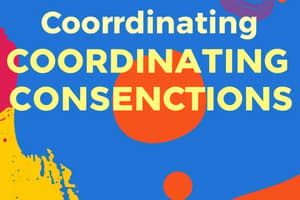Podcast
Questions and Answers
Which coordinating conjunction primarily indicates a contrasting relationship?
Which coordinating conjunction primarily indicates a contrasting relationship?
- For
- And
- But (correct)
- Or
What is the purpose of the coordinating conjunction 'so'?
What is the purpose of the coordinating conjunction 'so'?
- To present alternatives
- To indicate a surprising contrast
- To provide a reason
- To imply a consequence (correct)
Which of the following sentences correctly uses a comma before a coordinating conjunction?
Which of the following sentences correctly uses a comma before a coordinating conjunction?
- He loves to hike but he hates to camp.
- I wanted to stay home, yet I went to the party. (correct)
- I wanted to go for a walk and it started to rain.
- She can go to the party or stay home, it’s her choice.
Which of the following is NOT a common coordinating conjunction?
Which of the following is NOT a common coordinating conjunction?
What does the acronym FANBOYS represent in relation to coordinating conjunctions?
What does the acronym FANBOYS represent in relation to coordinating conjunctions?
Flashcards are hidden until you start studying
Study Notes
Coordinating Conjunctions
-
Definition: Coordinating conjunctions connect words, phrases, or clauses that are similar or equal in structure.
-
Common Coordinating Conjunctions:
- For
- And
- Nor
- But
- Or
- Yet
- So
-
Acronym: Remember the acronym FANBOYS to easily recall these conjunctions.
-
Usage:
- Connecting Words:
- Example: I like apples and oranges.
- Connecting Phrases:
- Example: She is reading a book but also watching TV.
- Connecting Clauses:
- Example: I wanted to go for a walk, but it started to rain.
- Connecting Words:
-
Punctuation:
- Use a comma before the coordinating conjunction when connecting two independent clauses.
- Example: I wanted to go to the store, but it was closed.
- Use a comma before the coordinating conjunction when connecting two independent clauses.
-
Examples in Sentences:
- "I wanted to stay home, yet I went to the party."
- "You can have tea or coffee."
- "He didn’t see the movie, nor did he read the book."
-
Subtle Differences:
- "And" adds information.
- "But" shows contrast.
- "Or" presents alternatives.
- "For" provides reason.
- "Yet" indicates a surprising contrast.
- "So" implies a consequence.
-
Common Mistakes:
- Avoid run-on sentences by properly using commas with conjunctions.
- Ensure parallel structure when connecting similar elements.
Coordinating Conjunctions Overview
- Coordinating conjunctions connect similar or equal elements in structure, including words, phrases, or clauses.
- The main coordinating conjunctions are For, And, Nor, But, Or, Yet, So.
Memorization Aid
- Use the acronym FANBOYS to remember the seven coordinating conjunctions.
Usage Examples
- Connecting Words: Example of usage includes "I like apples and oranges."
- Connecting Phrases: For instance, "She is reading a book but also watching TV" demonstrates the connection between phrases.
- Connecting Clauses: A typical example is "I wanted to go for a walk, but it started to rain," showcasing clause connection.
Punctuation Rules
- Always use a comma before a coordinating conjunction when linking two independent clauses.
- Example for clarity: "I wanted to go to the store, but it was closed."
Practical Examples
- "I wanted to stay home, yet I went to the party" illustrates contrast with 'yet.'
- Usage of 'or' in "You can have tea or coffee" shows the presentation of alternatives.
- Example with 'nor': "He didn’t see the movie, nor did he read the book" emphasizes the negative correlation.
Nuanced Meanings
- "And" adds information or connects similar ideas.
- "But" indicates a contrast between ideas or clauses.
- "Or" offers choices or alternatives.
- "For" gives reasons or explanations.
- "Yet" shows a surprising contrast.
- "So" conveys a causal relationship.
Common Errors to Avoid
- Prevent run-on sentences by using appropriate commas with conjunctions.
- Maintain parallel structure when connecting similar elements for clarity and coherence.
Studying That Suits You
Use AI to generate personalized quizzes and flashcards to suit your learning preferences.




